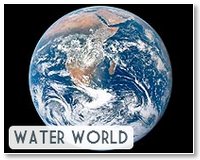| . |  |
. |
Geneva (AFP) Feb 10, 2011 A report for the Swiss and Swedish governments warned on Thursday that water shortages in the Middle East were so alarming that opposing camps in the region would have little choice but to cooperate. Swiss Foreign Minister Micheline Calmy-Rey called for closer cooperation between Turkey, Iraq, Syria, Lebanon, Jordan, the Palestinians and Israel on managing increasingly scarce water resources, arguing that water could also be used to forge a "blue peace." "The report comes to an alarming conclusion; five of the seven countries are experiencing a structural shortage and debit of most of the big rivers has declined by 50 to 90 percent between 1960," she told journalists. "In the future the main geopolitical resource in the Middle East will be water more than oil," she added, warning that it was closely tied to peace efforts. The report by an Indian thinktank, Strategic Foresight Group, highlighted huge depletion of major rivers such as the Jordan and Yarmouk in the past half a century, the punctual depletion of the Euphrates by drought and the shrinkage of the Dead Sea to a small lake by 2050. However, the report also acknowledged the difference between the countries, with upstream Turkey in a position to "influence prospects of peace" despite the collapse of 1980s plan to pipe water to Israel and Gulf states. Downstream territories such as Israel, Jordan and Palestinian territories were in the worst position with mounting clean water deficits of up to 500-700 million cubic metres each. The report also argued that technical solutions such as desalination or wastewater recycling in Israel would ultimately have limited scope. "Purely unilateral solutions will mainly work for a decade or so but Israel will have to look for external sources and regional cooperation beyond 2020 to ensure its water security," it said. Swiss diplomats said they had already started to lobby the seven governments for a joint water cooperation council expanding on an nascent Turkish, Iraqi, Jordanian and Syrian effort, as well as other steps, even if they admitted that it would be challenging.
earlier related report The U.S. Geological Survey report said the latest of three intentional floods from the Glen Canyon Dam, unleashed in March 2008, created lasting Colorado River sandbars to benefit fish, wildlife and river-running campers, The Salt Lake Tribune reported Thursday. However, the spring flood caused a population explosion in non-native rainbow trout that eat and compete with the endangered humpback chub, the report said in suggesting the U.S. Bureau of Reclamation consider fall floods in the future. Sandbars on the river have dwindled since the government finished Glen Canyon Dam in 1963. Where still present, they form pools for native fishes and beaches for wildlife and recreation. Short floods from the dam can help, the report says. Of 34 river sandbar study sites, researchers say, 31 were larger just after the spring 2008 flood. "It does seem to be somewhat encouraging," said Ted Melis, deputy chief of the USGS Grand Canyon Monitoring and Research Center. Interior Secretary Ken Salazar has ordered the Bureau of Reclamation to prepare a protocol to spell out conditions under which it will repeat the floods, and to also prepare a plan to keep rainbow trout in check.
Share This Article With Planet Earth
Related Links Water News - Science, Technology and Politics
 China earmarks $303 bn for safe water: report
China earmarks $303 bn for safe water: reportBeijing (AFP) Jan 21, 2011 China plans to invest $303 billion in water infrastructure projects over the next five years that would give millions of rural residents access to safe drinking water, state media reported. Severe flooding and droughts across the country last year destroyed crops and drove up food prices, pushing inflation to its highest level in more than two years, prompting the investment. Beijing wil ... read more |
|
| The content herein, unless otherwise known to be public domain, are Copyright 1995-2010 - SpaceDaily. AFP and UPI Wire Stories are copyright Agence France-Presse and United Press International. ESA Portal Reports are copyright European Space Agency. All NASA sourced material is public domain. Additional copyrights may apply in whole or part to other bona fide parties. Advertising does not imply endorsement,agreement or approval of any opinions, statements or information provided by SpaceDaily on any Web page published or hosted by SpaceDaily. Privacy Statement |